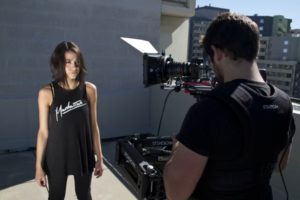A jump cut is a transition between scenes in a film that involves breaking a single shot with a quick cut, jumping between scenes. It creates a jarring effect for the audience by portraying a jump in time and skipping ahead to a later date.
Jump cuts differ from other editing techniques in that they make the edit made in the film very visible, rather than attempting to hide the fact that scenes were edited together. In order to qualify, a jump cut must include three key qualities: it violates space, fragments an action, and creates an ellipsis in time.
Jump Cuts in Film Explained
Using a jump cut in a film can help you portray a skip in time. Some filmmakers avoid using jump cuts, believing that they call unnecessary attention to the edited or constructed nature of a film. These filmmakers tend to believe that the story presented in film should instead showcase a seamless appearance in terms of space and time. The opposite of a jump cut is a match cut, which creates a smoother transition between two scenes.
You might choose to use a jump cut in your film to do the following:
- Amplify tensions in the scene
- Highlight the mental state of a character
- Create a montage
- Introduce a new character
- Accent the timing of an interview, such as in a documentary
Where Did the Jump Cut Come From?
Jump cuts have been used in film since the early days of cinema. Georges Méliès, a magician, was one of the first to use this editing technique, which he implemented to create the illusion of magic tricks happening on the screen. What is particularly interesting about the introduction of this technique is that Méliès happened upon it by accident. His camera jammed and when he reloaded it, he discovered that while the people in the scene had jumped, the setting remained unchanged.
Following Méliès, other filmmakers sought to bring jump cuts into narrative filmmaking in a natural way. Between the 1920s and 1950s, filmmakers sought to become invisible in their roles, hiding the construction of the film and presenting the narrative in a way that allowed the audience to immerse themselves in the story.
Jump Cuts and the French New Wave
While Hollywood focused on creating seamless narrative films, Jean-Luc Godard served as one of the pioneers of the French New Wave movement, which launched the modern use of the jump cut. Godard’s film, “Breathless,” is one of the most notable to come out of the movement and shatters the traditional expectations that audiences had for love stories. He intentionally disrupted the invisibility valued by mainstream directors, making quick and abrupt jump cuts between moments in time.
How We Use Jump Cuts Today
You can see jump cuts in films across all genres, although they are especially popular in internet videos and vlogs. The jarring quality of a jump cut can be especially useful in online videos, becoming a stylistic dangling carrot for the viewer and allowing them to quickly and easily consume the information presented. Online videos featuring jump cuts can encourage viewers to watch the content, while the option to use this editing technique benefits DIY filmmakers who don’t have the space or equipment to set up various scenes.
How and When to Use Jump Cut Editing
A jump cut can be a practical solution when you’re creating video on a smaller scale, such as for your social media platforms. You may not have the space for multiple camera setups or the equipment to handle smoother transitions. By utilizing jump cuts in your editing process, however, you can create engaging videos that don’t need multiple camera angles or b-roll footage to cover your edits.
Avoiding Jump Cuts
As mentioned, some directors avoid using jump cuts to create a more cohesive finished product. If you want to avoid using this editing technique, it’s helpful to vary your shot composition and camera angles, cutting between different types of shots.
Embracing Jump Cuts
Although some directors don’t like jump cuts, many agree that this technique has its place and can provide several key advantages.
When you want to quickly show the passing of time or speed up a sequence, a jump cut can achieve both of these objectives.
Jump cuts can also set up a mood or be used to provide the audience with comedic relief.
Cutting Between People
When a scene includes people, jump cuts can be disconcerting when you use certain shots. For example, if you have a shot that includes one character and then immediately jump to a shot of a different character in the same position as the first character, it may create the illusion that one has turned into the other.
Jump Cut Strategies
If you want to use jump cuts in your films, follow these strategies to make the editing technique as effective as possible.
Make a Montage
Jump cuts work well when being used in a montage, allowing the audience to experience various moments in time grouped together. One example is in “Schindler’s List,” a Steven Spielberg film, when the montage provides a comedic experience during a somber drama about the Holocaust.
Create or Amplify Tension
Jump cuts can also increase the tension as the characters move through time quickly. In “Run Lola Run,” the title character runs through scenarios of how she could quickly get the money needed to pay off a crime boss. The director uses jump cuts to signify the anxiety she feels, putting the audience into her mindset.
Introduce New Characters
You can use a jump cut to introduce a new character to the narrative, helping to convey information quickly and efficiently. An example of this use of jump cuts is evident in the title sequence of “Snatch.”
Highlight Characters’ Mental States
The mental state of a character in your film can be highlighted by a series of jump cuts. For example, in “The Royal Tenenbaums,” director Wes Anderson used this editing technique to show the frazzled state of Ritchie, Luke Wilson’s character, before he attempts suicide. Jump cuts can portray any mental state, including the instability showcased in this particular scene.
Organize Interviews in Documentaries
In documentaries, interviews are often key components of the story being told. However, interviews don’t provide much action for the audience, so using jump cuts helps to move between interview segments or organize the information being presented. The purpose of this editing technique in a documentary is often to string together a more cohesive narrative.
You can create your own unique videos with jump cuts to practice the editing technique. Try performing a magic trick or making a character disappear. Follow these tips to implement jump cuts as you create films.
If you’re interested in learning more about jump cuts, apply to Nashville Film Institute to gain professional qualifications as a filmmaker.














